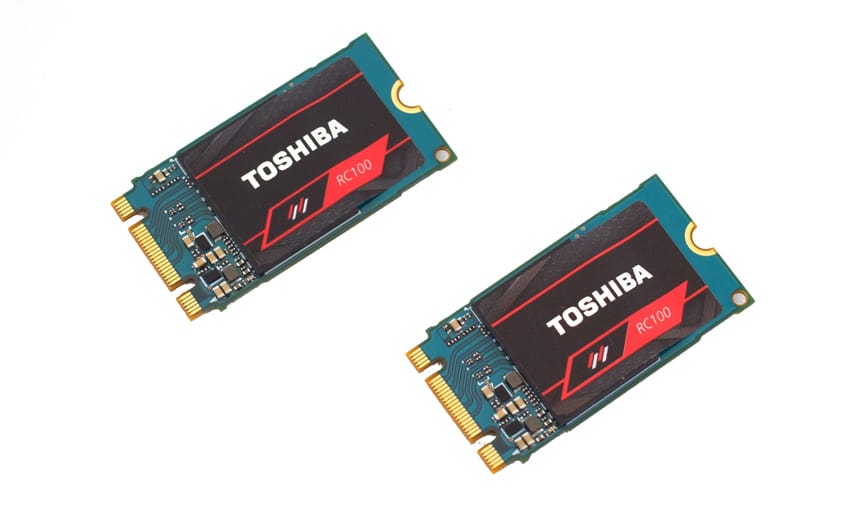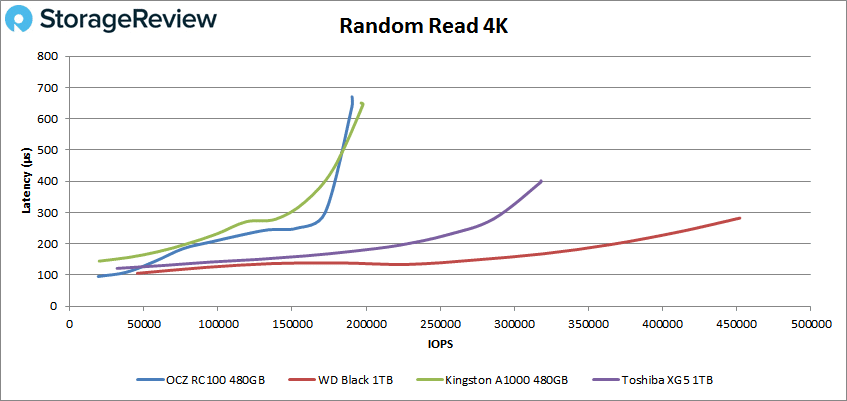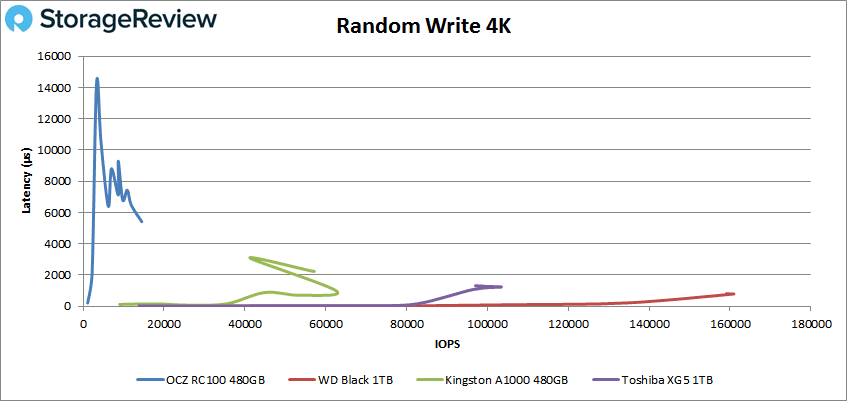Toshiba Rc100 M2 2242 240gb and 480gb Ssd Review - Tiny Nvme
 Toshiba is looking to enter the mainstream end-user NVMe stage with the OCZ RC100 Serial SSD. Launching at a competitive price point, the RC100 is designed for those looking to upgrade their rigs to the much faster NVMe technology, fitting in the middle of their SATA (such as the OCZ TR200) and higher-end NVMe SSDs (such as the RD400). Eventually NVMe volition supplant SATA in PCs, offering solutions for value and an alternate line for performance. Toshiba is getting out ahead of the curve with the RC100 equally it tries to accost that infinite.
Toshiba is looking to enter the mainstream end-user NVMe stage with the OCZ RC100 Serial SSD. Launching at a competitive price point, the RC100 is designed for those looking to upgrade their rigs to the much faster NVMe technology, fitting in the middle of their SATA (such as the OCZ TR200) and higher-end NVMe SSDs (such as the RD400). Eventually NVMe volition supplant SATA in PCs, offering solutions for value and an alternate line for performance. Toshiba is getting out ahead of the curve with the RC100 equally it tries to accost that infinite.
Toshiba is looking to enter the mainstream finish-user NVMe stage with the OCZ RC100 Series SSD. Launching at a competitive price point, the RC100 is designed for those looking to upgrade their rigs to the much faster NVMe engineering, fitting in the middle of their SATA (such as the OCZ TR200) and higher-stop NVMe SSDs (such every bit the RD400). Eventually NVMe will supersede SATA in PCs, offering solutions for value and an alternate line for performance. Toshiba is getting out ahead of the curve with the RC100 as it tries to address that space.

The RC100 features and the Toshiba'southward 64-layer BiCS FLASH, the latter which combines functioning, cost, and endurance for all types of SSDs. To drive down the cost further, the new Toshiba drive uses a cost-effective single-packet, DRAM-less design to enable a functioning-driven experience at a fraction of the power usage compared to other NVMe drives. The RC100 also uses the more compact (shorter) M.2 2242 form factor versus longer 2280 grade factor.

As far equally functioning goes, the RC100 is quoted to deliver up to 1,600MB/s in sequential reads and one,100 MB/south in sequential writes, while random reads and writes are expected to hit a maximum of 150,000 IOPS and 110,000 IOPS, respectively.
Backed by a 3-twelvemonth warranty, the RC100 comes in capacities of 128GB ($60), 240GB ($80) and 480GB ($155). We will be looking at the 480GB model.
Toshiba OCZ RC100 Serial SSD Specifications
| Form Cistron | M.two Type 2242-S3-B-K | |||||
| Interface | PCI Limited Base Specification Revision 3.1a (PCIe) | |||||
| Controller | Toshiba | |||||
| NAND Flash Memory | 64-layer 3D BiCS TLC V-NAND | |||||
| Capacities | 128GB, 240GB and 480GB | |||||
| Operation | ||||||
| Sequential Read MB/s | Up to 1,600MB/s | |||||
| Sequential Write MB/s | Up to ane,100MB/s | |||||
| Random Read 4K IOPS | Upward to 150,000 KiB IOPS | |||||
| Random Write 4K IOPS | Up to 110,000 KiB IOPS | |||||
| TBW | 240 | |||||
| Power | ||||||
| Supply Voltage | three.three V ±5 % | |||||
| Power Consumption (Active) | three.20 W (typ.) | |||||
| Power Consumption (L1.2 Ability) | 5 mW (typ.) | |||||
| Warranty | three-years | |||||
Design and Build
At just 42mm in length and ii.38 mm in height, the Toshiba OCZ RC100 is one of the smallest SSDs yous'll see on the market. Toshiba is able to fit it on the tiny K.2 2242 PCB because the entire SSD is contained within a unmarried BGA chip. This makes it ideal for those looking to maximize the space within their system, such equally tablets and other ultra-portable systems.

The front side of the RC100 has a sticker that covers the NAND chips and most of the PCB, which uses the blueprint you've seen on other recent Toshiba/OCZ SSDs. Information technology displays minimal data including the Toshiba branding and the model number. All capacities use the 64-layer 3D BiCS TLC 5-NAND.
On the other side is a sticker on top of a blank PCB that displays more detailed information, including the form factor, capacity size certifications information.
Operation
Houdini by SideFX
The Houdini test is specifically designed to evaluate storage performance equally it relates to CGI rendering. The test bed for this awarding is a variant of the core Dell PowerEdge R740xd server type we utilize in the lab with dual Intel 6130 CPUs and 64GB DRAM. In this case we installed Ubuntu Desktop (ubuntu-sixteen.04.three-desktop-amd64) running bare metal. Output of the benchmark is measured in seconds to complete, with fewer being improve.
The Maelstrom demo represents a section of the rendering pipeline that highlights the functioning capabilities of storage by demonstrating its ability to effectively apply the swap file every bit a form of extended retentivity. The exam does not write out the effect information or process the points in social club to isolate the wall-time issue of the latency impact to the underlying storage component. The test itself is composed of v phases, three of which nosotros run as part of the criterion, which are as follows:
- Loads packed points from disk. This is the time to read from deejay. This is unmarried threaded, which may limit overall throughput.
- Unpacks the points into a single apartment array in guild to allow them to be processed. If the points do not have dependency on other points, the working prepare could be adapted to stay in-core. This step is multi-threaded.
- (Not Run) Process the points.
- Repacks them into bucketed blocks suitable for storing back to disk. This step is multi-threaded.
- (Not Run) Write the bucketed blocks back out to disk.
When looking at the functioning of rendering fourth dimension (where less is amend), we run into troublesome results right abroad. Hither, the RC100 480GB plant itself at the bottom of the pack with four,240.8 seconds, which was merely amend than the Kingston A1000 of the same capacity.
VDBench Workload Analysis
In our outset VDBench Workload Analysis, we looked at random 4K read performance. In this workload scenario, the RC100 placed well behind the leaders and in last place with a meridian operation of 190,597 IOPS and 664.6μs latency for the 480GB capacity.

Looking at 4K writes, the results were disappointing, to say the to the lowest degree. As you tin can see from the chart below, the RC100 was last place past a large margin and with latency spikes throughout the examination (at i point it hit 14,291μs). More than specifically, the new Toshiba bulldoze had peak functioning at simply 14K IOPS and five,419μs.

Switching gears to our 64K benchmarks, the RC100 placed third among the comparables, slightly outpacing the Kingston drive. Here, information technology had peak performance of 773.69MB/south and a latency of 1,358.7μs.

Unfortunately, the Toshiba drive slowed down to a snail'southward stride with write functioning once again equally the chart conspicuously demonstrates. For 64K write, the 480GB RC100 placed well backside the other drives in both latency and throughput with a very disappointing peak performance of 49.26MB/south and 19,522μs.

We usually include a VDI benchmark as part of terminate-user SSD testing. Unfortunately the RC100 failed to consummate the test in both the 240GB and 480GB capacities. Equally a outcome we have no data to share for this benchmark.
Conclusion
On paper, the Toshiba's RC100 drive sounds like a great production for allowing mainstream consumers to finally get their easily on a depression-cost NVMe drive at just $eighty for the most pop mid-range capacity. Toshiba's drive features the visitor'south new 64-layer BiCS Flash and a cost-constructive single-package, DRAM-less design to bulldoze down the toll inside the tiny. The RC100 also uses the more than compact Yard.2 2242 course factor versus larger 2280 grade factor M.2 2242 class factor, giving it a picayune more flexibility in deployment. Toshiba also quotes a solid one,600MB/s in sequential reads and 1,100 MB/s in sequential writes, which is almost 5 times the speed of consumer SATA SSDs. Despite all of this, we were very disappointed with the write operation results of Toshiba's new OCZ drive.
Its poor operation began in our Houdini test it came in second to terminal with iv,240.8 seconds for the 480GB chapters. In our VDBench Workload Assay, the RC100 hit a height performance of 190,597 IOPS and 664.6μs and 773.69MB/s and i,358.7μs for the random 4K reads and sequential 64K reads, respectfully. These placed it effectually the last identify position, right forth with the Kingston drive. Write, nevertheless, were much worse, where the drive had peak performance at simply 14K IOPS and 5,419μs and 49.26MB/s and xix,522μs in our random and sequential charts. This was significantly backside all other tested drives. The bulldoze failed to complete the VDI workloads.
Overall, it was disappointing to see the write speed hit on the RC100, every bit the market is fix for large companies like Toshiba to release well-performing, still affordable consumer NVMe drives. For many buyers it will come up down to price, or a size requirement to choose the RC100, but if there is some elbowroom, better alternatives be.
Bottom Line
Unless there are hefty toll cuts down the route, those looking for an affordable performant NVMe drive volition take to expect elsewhere, equally the drive has an uphill battle against the competition.
Toshiba RC100 on Amazon
Discuss This Review
Sign up for the StorageReview newsletter
Source: https://www.storagereview.com/review/toshiba-ocz-rc100-series-ssd-review
0 Response to "Toshiba Rc100 M2 2242 240gb and 480gb Ssd Review - Tiny Nvme"
Post a Comment